
Any program of dramatic change sounds preposterous when first proposed, especially when it runs up against a decades-long status quo. But change is the only constant, and you should never bet on inertia over determined change makers, no matter how bold or preposterous their plans.
I got involved in organizing at UMass for many reasons, but mainly one: to put a stop to year-after-year budget cuts and fee increases that were threatening thousands of students’ access to an affordable education. I worked on this for a combined eight years—four as a student (three as student trustee) and four working for PHENOM. We had some important victories and organizing successes, but these did not stop the trend of budget cuts and fee increases. Essentially all decision makers—administrators, trustees, and legislators—were either resigned to this cycle or were dismissive of and hostile to alternatives.
Suddenly, with this year’s budget, we have ourselves a paradigm shift. Not only did public higher education get a significant funding boost, not only did all 29 public campuses freeze fees for the first time in a generation, but we also got a solid commitment from the Governor, the Legislature, and all campus administrations that public campuses should be at least 50% state funded.
The House leadership has already committed to greater funding for next year. Of course we’ll still need to defend this commitment. But this is a very different place than we were eight years ago and it’s important to take a moment to recognize this victory. From now on, the “50/50” line is one we can defend as a “do not cross” line in times of budget cuts. Meanwhile the fee freeze—the first legislative action to directly keep student costs down in a long time—is only the first step in pushing ahead on issues of funding, affordability, and access.
Whenever I see a victory in a campaign, small or large, I flash back to those early meetings where we first started talking about the issue. You know the kind: usually 5-10 people doing somewhat unfocused brainstorming, coming up with slogans and organization names. I remember these because in many ways they’re just as pivotal as the large actions near the turning point. I’ve had the privilege of having a lot of these meetings with a lot of amazing people and watching these efforts grow into strong coalitions and winning campaigns, and of working with and learning from some amazing organizers.
It’s impossible to acknowledge everyone who made this possible. Two straight years of lobby days that packed the halls of the State House, thousands of phone calls and letters, unprecedented cooperation among higher ed stakeholders, tons of hard work by our allies and champions in the legislature, and of course countless days of organizing meetings, trainings, and coalition-building efforts all contributed.
Everyone involved, whether you were there at the beginning or joined recently, whether you participated in one action, signed one petition, gave a few bucks, or lived and breathed this work every day, you have my gratitude and respect.
There’s still more to be done. For many, accessing college may seen impossible. For others, graduating without a ton of debt seems impossible. We need to do something about the more than a trillion dollars in student debt nationally. And we need to get real reinvestment into public higher education. And we need to make it truly affordable. And we need to make education, eventually, free. Sound like a tall order? Yeah. But so was imagining—and getting—a renewed commitment to public higher education.
